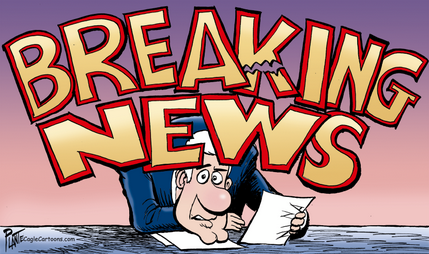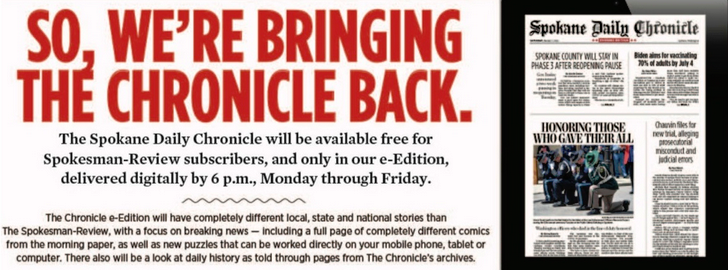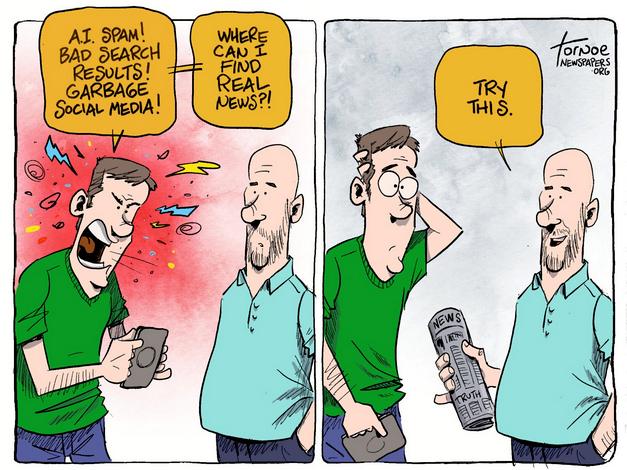Newspaper News
Skip to comments
Shares of Gannett Are Soaring Today
Analysts at Citigroup placed Gannett on a “90-day positive catalyst watch” this morning.
Shares of the large publisher Gannett (GCI 18.66%) zoomed 18% higher this morning after Citigroup analyst Jason Bazinet placed the stock on a “90-day positive catalyst watch” and upgraded his rating to neutral. Bazinet believes the U.S. Department of Justice’s current lawsuit against Alphabet‘s Google could have positive ramifications for Gannett.

Bram Berkowitz at The Motley Fool explains why Gannett stock “zoomed” higher today.
Gannett is the country’s largest newspaper and digital publisher and owns several big media brands, such as USA Today. In 2019, New Media Investment Group, another large publisher, acquired Gannett but continued operating under the Gannett brand. The acquisition required the company to take on a massive amount of debt. Since then, it’s been an uphill battle as the print newspaper business has continued to experience disruption.
This year, however, shares have popped 120% as the company has shown promising execution on its digital transformation. Digital revenues now comprise 44% of total revenue, and management believes that number will reach 50% by next year.
**********
The future is not all bleak
Layoffs. Buyouts. Staff reductions. Economic headwinds. Re-organizations. News fatigue. Mistrust. Distrust. No trust.
These are some of the words and phrases that many people use nowadays to describe the state of journalism and the news business.
But is it really that bad? Is it all just a bunch of doom with a heavy dose of gloom?
Actually, no.

Poynter reporter Tom Jones interviews Poynter president Neil Brown about the state of newspapers.
NB: What I am saying is the story of journalism and the news industry in decline is, one, partly tired and, two, incomplete and not current because other things are coming forward. And despite this sort of narrative that there’s news fatigue, there’s profound news interest.
**********
The Salt Lake Tribune, profitable and growing
The first daily newspaper in the U.S. to become a nonprofit has published a refreshingly readable and transparent annual report.
News organizations have historically sought to maintain a strict separation between business and editorial operations to protect newsroom independence, and it’s been said — maybe not unfairly — that journalists don’t know much about the business of news. There are signs that is changing, however, and reporters have not failed to notice that more than two-thirds of newspaper jobs have vanished since 2005 or that local news outlets have been hit particularly hard. We’ve seen news organizations open communication that gives journalists a better idea of what, exactly, needs to happen for their publication to survive and thrive — and where they fit in.

Let’s start with the bottom line, shall we? The Salt Lake Tribune made $15.3 million last year for a net revenue of $779,000. The nonprofit newspaper makes most of its money from donors ($3.3 million in 2023), subscribers (about $5 million), and advertising ($5.2 million).
About a third of the donation revenue comes from individuals. The vast majority (87%) of individual donors give tax-deductive gifts of $100 or less, but the Tribune has grown its First Amendment Society (more than $1,000/year) to 136 members. The names of donors giving more than $5,000 is publicly available on the site.
**********
Navigating the print runway: Strategic pricing for a digital-first future
- Publishers facing an urgent need for immediate revenue and cash flow may opt for more aggressive pricing tactics, but this must be done strategically to minimize unnecessary churn.
- The carrier-based distribution model remains under severe strain, with open routes increasing nationwide and labor competition at an all-time high, raising concerns about its long-term sustainability.


In this article, Peter Doucette and Matt Lindsay | Mather Economics explore the strategic considerations publishers must address. Via America’s Newspapers.
As economic pressures mount and consumers become more selective with their spending, publishers must adopt a thoughtful approach to pricing and product strategy to maintain loyalty while transitioning print readers to digital formats.
**********
This newspaper revived the evening edition it closed 29 years ago
[D]uring the pandemic, Curley started to mull another idea. What if The Spokesman-Review could give readers something more in the afternoon? And what if it tied that product to the extinct paper a lot of people loved?
“They always think I’m nuts,” Curley said, “but this was next level nuts.”

The Spokane Spokesman-Review revives The Spokane Chronicle as an afternoon digital newspaper.
When newspapers came out more often than just in the morning, they served different functions. The morning papers got the who, what, when and where, Curley said, and the afternoon papers followed up with the how and why.
Now, he said, the roles have flipped. In a time when everyone can know almost everything thanks to the internet, the morning paper offers context.
The Chronicle, usually available to readers between 6 and 7 p.m., runs the latest news reported that day.
Kristen Hare for Poynter reports on an innovative way for newspaper to build customer loyalty.
**********
What Google’s monopoly ruling means for local newspapers
[A] few years ago if a local business wanted to advertise, they’d come to the local newspaper, the most effective place to promote a local business. That advertising revenue was used to pay journalists to cover your town hall meetings, high school sports and local events. Newspapers were the watchdogs, keeping an eye on your local government and celebrating your community’s achievements.

Back to our opening story as Dean Ridings, America’s Newspapers CEO, explains Google’s drag on newspapers.
Enter Google. As they exerted their influence on the advertising market, those local advertising dollars started flowing to them instead of your hometown newspaper. The impact was significant and newspaper advertising revenue has continued to decline. The result? Fewer reporters on the street. Less coverage of your local issues. Some newspapers have even had to shut their doors completely. And since Google has no local reporters (they take the content from local newspapers and other sources), local news and information gets harder to find.
Google’s actions have had a very real impact on your community. When local news suffers, studies show that voter turnout drops, corruption goes unchecked and people feel less connected to their neighbors.
feature image by Charles Schulz from the August 18, 1951 Peanuts comic strip © Peanuts Worldwide


Comments 2
Comments are closed.